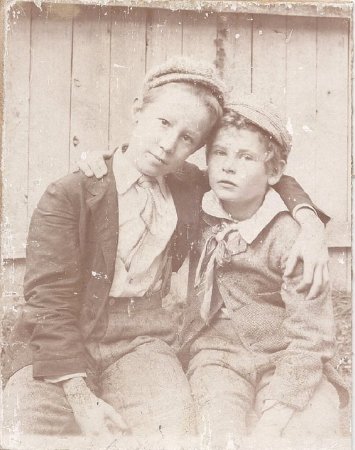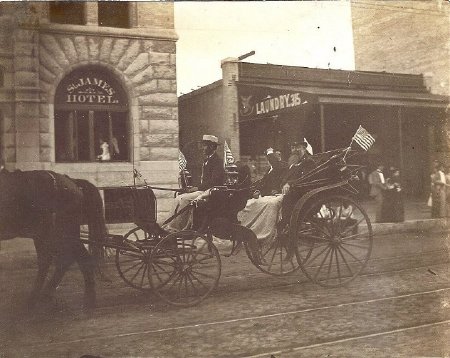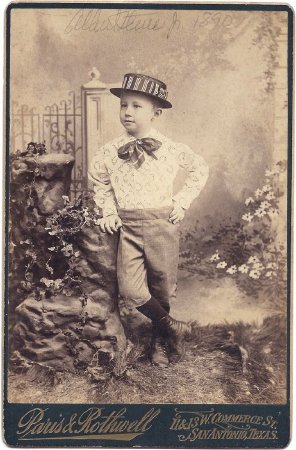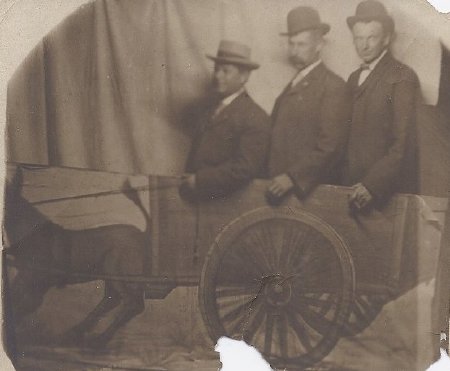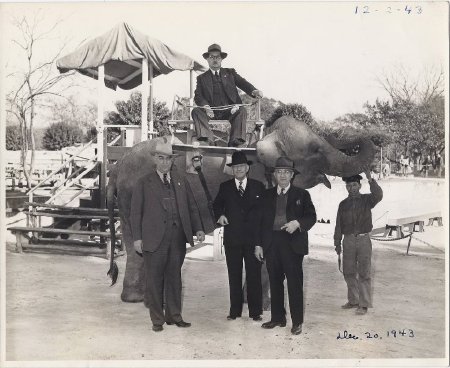Boy's & Men's Hats
About this Image:
1) Two of the Steves boys, Albert Jr. (1884-1945) and Edward M. (1889-?), strike a friendly pose in this outdoor photo. Note their flat, cloth caps and the loose ties worn beneath soft, wide collars on their shirts. Young men of all classes favored these sporty newsboy caps from the late 1800s through the early 1900s.
2) Gustav A. Duerler (1841-1928) and Ferdinand Herff, Jr.(1852-1927) ride down Houston Street in a flag-decorated carriage in the 1898 Fourth of July parade. Both men wear formal top hats, probably silk, and protect their trousers from dust with a fringed lap robe. The carriage driver sports a more casual straw boater hat.
Herff, son of medical pioneer Ferdinand Herff Sr., retired as president of the First National Bank, while Duerler established a confectionary and, eventually, Duerler Manufacturing Co.
3) Albert Steves Jr.(1884-1945) shows off a number of fine accessories, from his straw boater hat to his colorful necktie and button dress boots, in this studio portrait. His knickers stop just below the knee and button on the side, illustrating that the main difference between men's and boy's clothes from the 1870s to the 1940s was the length of their pants.
4) Three men, identified only as Baker, Burton, and Neely, pose behind a donkey cart prop at the 1906 San Antonio Fair. The man in front wears what may be a Homburg hat (although the crown apears very low), while his friends wear high-crowned bowlers.
The Homburg first achieved popularity in the 1890s, after the Prince of Wales (later King Edward VII) brought the style back from a visit to Germany. From England, the style spread worldwide. Made of stiff felt, the hat featured a crease from front to back in the crown, a ribbon hatband, and a slightly upturned brim.
5) Antonio Villalobos, head of Mexico's dominant political party at the time (Presidente del Comite Central Ejecutivos del P.R.M.), sits on top of an elephant at the San Antonio Zoo. The visiting dignitaries all wear fedora hats, which are distinguished by the center-creased crown with two pinches in the front, and a wide brim. The fedora started out as a woman's hat style, but was adopted by men in the 1920s and continued to be popular for decades.
Standing left to right: Fire and Police Commissioner Preston Anderson (1889-1952), Mayor Gus Mauermann (1887-1964), Fernando de la Garza, and a zoo keeper. De la Garza was head of the Mexican Federal Office of Tourism. To learn more about these gentlemen, check out the WWII exhibit.
2) Gustav A. Duerler (1841-1928) and Ferdinand Herff, Jr.(1852-1927) ride down Houston Street in a flag-decorated carriage in the 1898 Fourth of July parade. Both men wear formal top hats, probably silk, and protect their trousers from dust with a fringed lap robe. The carriage driver sports a more casual straw boater hat.
Herff, son of medical pioneer Ferdinand Herff Sr., retired as president of the First National Bank, while Duerler established a confectionary and, eventually, Duerler Manufacturing Co.
3) Albert Steves Jr.(1884-1945) shows off a number of fine accessories, from his straw boater hat to his colorful necktie and button dress boots, in this studio portrait. His knickers stop just below the knee and button on the side, illustrating that the main difference between men's and boy's clothes from the 1870s to the 1940s was the length of their pants.
4) Three men, identified only as Baker, Burton, and Neely, pose behind a donkey cart prop at the 1906 San Antonio Fair. The man in front wears what may be a Homburg hat (although the crown apears very low), while his friends wear high-crowned bowlers.
The Homburg first achieved popularity in the 1890s, after the Prince of Wales (later King Edward VII) brought the style back from a visit to Germany. From England, the style spread worldwide. Made of stiff felt, the hat featured a crease from front to back in the crown, a ribbon hatband, and a slightly upturned brim.
5) Antonio Villalobos, head of Mexico's dominant political party at the time (Presidente del Comite Central Ejecutivos del P.R.M.), sits on top of an elephant at the San Antonio Zoo. The visiting dignitaries all wear fedora hats, which are distinguished by the center-creased crown with two pinches in the front, and a wide brim. The fedora started out as a woman's hat style, but was adopted by men in the 1920s and continued to be popular for decades.
Standing left to right: Fire and Police Commissioner Preston Anderson (1889-1952), Mayor Gus Mauermann (1887-1964), Fernando de la Garza, and a zoo keeper. De la Garza was head of the Mexican Federal Office of Tourism. To learn more about these gentlemen, check out the WWII exhibit.
Credit:
Courtesy of San Antonio Conservation Society Foundation

